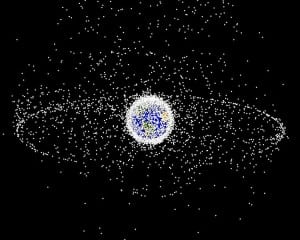Lockheed Martin and EOS to Open Space Debris Tracking Site in Australia

Rendering of projected orbital debris in two primary fields: the ring of objects in geosynchronous orbit (GEO) and the cloud of objects in low Earth orbit (LEO). Photo: Wikimedia Commons
[Via Satellite 12-02-2015] Lockheed Martin and Electro Optic Systems (EOS) have broken ground on a new space object tracking facility in Australia that aims to provide commercial and government customers an enhanced view of orbital space debris fields. The new space object tracking site will give satellite operators a clearer picture of the debris that could damage their networks, and how they can avoid potential collisions.
The network developed by EOS and Lockheed Martin, called Optical Space Services (OSS), was formed in August 2014. Electro optical systems like OSS serve as a complement to radar-based systems like the U.S. Air Force’s Space Fence, which will sweep the sky tracking 200,000 objects.
Sensors, lasers and optic systems will be fused together by software enabling OSS to hone-in on, characterize, and track human-made objects orbiting the depths of space. That data will then be quickly and accurately delivered to customers allowing them to maneuver satellites and prevent collisions. The system can also predict the paths of debris, giving operators advance warning of potential collisions, according to Lockheed Martin.
“This new tracking capacity will provide unique data which is exclusively available to EOS and Lockheed Martin, enabling each organization to offer both data and services to meet global market needs. Based on current contracts and active negotiations, EOS expects to commence the delivery of data and services by late 2016,” said Ben Greene, EOS chief executive officer.